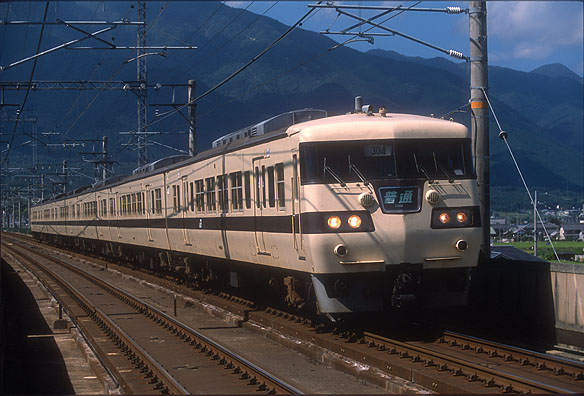Background and overview
In 1979, Japanese National Railways (JNR) developed 117 series suburban
DC electric multiple unit (EMU) trains in order to replace superannuated
153 series express EMU trains used on the special rapid services in the
Keihanshin region. 117 series matched the passenger accommodation offered
by competing services and provided JNR with a train designed for the transit
conditions in the Keihanshin region. Their formation consists of 4 motored
vehicles and 2 trailer vehicles.
Car body
Bodies are constructed by steel. They feature a built-in classification
headboard directly below the windscreens' centre post. They are equipped
with 2 double-leaf semi-automatic sliding doors on each side of the vehicles.
They are equipped with pairs of double-hang unit assembled side windows,
the upper sash of which moves down and the lower moves up, between the
doors and a destination rollsign on each side of the body. An air conditioner,
AU75B rated at 42,000kcal/h, is fitted on the centre of their roof. Electric
powered intake fan units are fitted on the both side of the air conditioner
and no ventilators on the roof. End cars are equipped with the automatic
jumper coupler to ease rush-up operations when creating 12-car sets for
peak hours. Their livery was cream with a narrow horizontal maroon band
below the windows.
Bogies
While earlier suburban EMU trains featured coil spring bogies, 117 series featured DT32H/TR69K air suspension bogies, which has results of 165 series, among suburban electric trains of JNR for the first time, in order to realize improved stability.
Traction unit and ancillary equipments
Eight series-wound brushed DC traction motors, MT54D, rated at 120 kW are controlled by armature-resistance traction control system, CS43A. The gear ratio is 4.82 to get high service speed at 110km/h and high acceleration performance. Type Moha117 vehicles are equipped with a diamond-shaped current collector, PS16J, featuring the protection against snow. 117 series adopt electromagnetic straight air brake. The rheostatic brake and holding brake are available.
Accommodation
Passenger accommodation is switchable transverse seating with 910mm seating
pitch. The passenger saloons use fluorescent lighting with covers. An AC
duct is installed above the ceiling and slit-shaped AC vents are featured
in order to improve interior design. The interior had wood trim intended
to set 117 series EMU apart from earlier suburban EMU trains. End cars,
Kuha116, are equipped with a Japanese style toilet.
Additional delivery
117 series were built again in 1982, in order to replace superannuated
153 series EMU used on the ordinary and rapid services in the Nagoya area.
The vehicles built in 1982 have some differences. The current collector
was changed into PS16 because they are not used in snowfall area. Side
doors are fully automatic. End cars, kuha117, are also equipped with a
Japanese style toilet beside kuha116. They are also not equipped with the
automatic jumper coupler.
Although all of 117 series were 6-car formation of 4M2T, the formations
of 117 series used in Nagoya area were supposed to make shorter in 1986.
So only the end cars (Kuha117-100 and Kuha-116-200) were built, and 117
series in Nagoya area were changed into 4-car formation of 2M2T.
Operations
In 1980, 117 series EMU entered the revenue service of the special rapid services linking Himeji and Kusatsu/Katata.
Maximum service speed was 110km/h at the beginning, but it was improved to 115km/h when 221 series started 120km/h operation.
In Osaka area, some 117 series withdrawn from the special rapid services
in 1990 began to be used on the rapid services of the Fukuchiyama line
after changing body colour. 117 series used on the Fukuchiyama line were
remodeled to 117-300 series.
A part of 117 series used on special rapid services were changed into 4-car formations of 2M2T and 8-car formations of 6M2T in 1991. The former was used on rapid services of the Nara line, and the latter was used on rapid services of the Tokaido line and the Sanyo line. Furthermore, 8-car formations were changed into 4-car formations and used on rapid services in Okayama area in 1992, and the remaining intermediate cars were included in 115 series. Moreover, 117 series used on rapid services of the Nara line were displaced with 221 series in 2001.
Now 117 series EMU are used on the ordinary and rapid services of the Kosei, Kusatsu, and Sanyo lines. |
|







